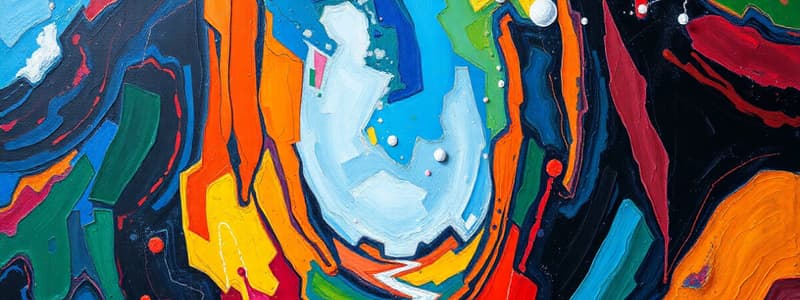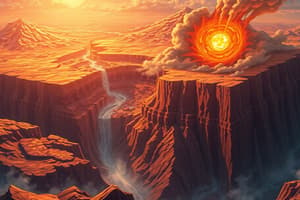Podcast
Questions and Answers
Earthquakes are a consequence of the abrupt discharge of ______ within the Earth's crust.
Earthquakes are a consequence of the abrupt discharge of ______ within the Earth's crust.
energy
The movement of tectonic plates is powered by heat-driven ______ within the Earth's mantle.
The movement of tectonic plates is powered by heat-driven ______ within the Earth's mantle.
convection currents
At convergent plate boundaries, one plate may be forced beneath another in a process called ______.
At convergent plate boundaries, one plate may be forced beneath another in a process called ______.
subduction
At ______ boundaries, plates move apart, creating tension and cracks in the Earth's crust.
At ______ boundaries, plates move apart, creating tension and cracks in the Earth's crust.
______ is when the Earth's crust breaks and shifts due to accumulated stress.
______ is when the Earth's crust breaks and shifts due to accumulated stress.
A ______ fault occurs when the crust is extended, causing the hanging wall to move downward relative to the footwall.
A ______ fault occurs when the crust is extended, causing the hanging wall to move downward relative to the footwall.
In a reverse fault, the hanging wall moves ______ relative to the footwall due to compressional forces.
In a reverse fault, the hanging wall moves ______ relative to the footwall due to compressional forces.
Human activities like mining and hydraulic fracturing can induce earthquakes, a phenomenon known as ______.
Human activities like mining and hydraulic fracturing can induce earthquakes, a phenomenon known as ______.
Flashcards
What are Earthquakes?
What are Earthquakes?
Sudden release of energy in the Earth's crust.
Tectonic Plate Movement
Tectonic Plate Movement
Movement of large sections of the Earth's lithosphere.
Convergent Boundaries
Convergent Boundaries
Plates collide; one slides under another.
Divergent Boundaries
Divergent Boundaries
Signup and view all the flashcards
Human-Induced Earthquakes
Human-Induced Earthquakes
Signup and view all the flashcards
Faulting
Faulting
Signup and view all the flashcards
Normal Faults
Normal Faults
Signup and view all the flashcards
Reverse (Thrust) Faults
Reverse (Thrust) Faults
Signup and view all the flashcards
Study Notes
- Earthquakes are natural events resulting from the sudden release of energy in the Earth's crust.
Causes of Earthquakes
- Tectonic plate movement refers to the motion of large sections of the Earth's lithosphere (tectonic plates) over the semi-fluid asthenosphere, driven by heat from the Earth's core, causing convection currents in the mantle.
- Earthquakes can be triggered by volcanic activity, fracturing surrounding rocks.
- Volcanic earthquakes are also referred to as volcanic-tectonic earthquakes
- Human activities like mining, reservoir-induced seismicity (from filling large reservoirs behind dams), and hydraulic fracturing (fracking) can cause earthquakes.
Types of Plate Boundaries
- Convergent boundaries involve two plates colliding or moving towards each other, potentially leading to subduction.
- Divergent boundaries occur where plates move apart, creating tension and cracks, and can lead to earthquakes along faults.
- Transform boundaries where plates slide past each other horizontally, can release stress and cause earthquakes.
Faulting and its Role in Earthquakes
- Faulting is a geological process where Earth's crust breaks and shifts due to accumulated stress.
- A fault is a fracture or zone of fractures between two blocks of rock, allowing relative movement.
Types of Faults
- Normal faults happen when the Earth's crust is extended or pulled apart, causing the hanging wall to move downward relative to the footwall.
- Reverse (thrust) faults occur when the crust is compressed, causing the hanging wall to move upward relative to the footwall.
- Strike-slip faults are primarily horizontal with little vertical displacement, move laterally, typically at transform plate boundaries.
Two Types of Strike Shift Fault
- Left lateral fault
- Right lateral fault
- Some regions have multiple interconnected faults, known as fault zones.
Studying That Suits You
Use AI to generate personalized quizzes and flashcards to suit your learning preferences.




